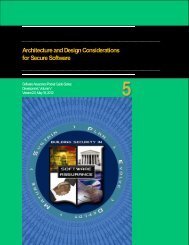Secure Coding SwA Pocket Guide - Build Security In - US-CERT
Secure Coding SwA Pocket Guide - Build Security In - US-CERT
Secure Coding SwA Pocket Guide - Build Security In - US-CERT
You also want an ePaper? Increase the reach of your titles
YUMPU automatically turns print PDFs into web optimized ePapers that Google loves.
systems is driving the definition of standards and technical solutions to provide more robust inter-agent authentication andaccountability without referencing back to a human user.Resources» “Overview of the Grid <strong>Security</strong> <strong>In</strong>frastructure.” Globus.org. 25 July 2010.» “Trust but Verify: Accountability for Network Services.” Yumerefendi, Aydan R. and Jeffrey S. Chase.<strong>In</strong>ternet Systems and Storage Group: Software architectures for <strong>In</strong>ternet-scale computing. September2004. The Department of Computer Science at Duke University, <strong>In</strong>ternet Systems and Storage Group.25 July 2010 .Leverage Attack PatternsProgrammers can use attack patterns to identify specific coding flaws targeted by relevant attacks and ensure that these flaws donot occur in their code. They first need to determine which attack patterns are applicable (i.e., which subset of available attackpatterns is relevant given the software’s architecture and execution environment) and which technologies are used to implementthe software. For example, the Buffer Overflow attack pattern would be relevant for a C or C++ program running on native Linuxbut not for a C# program running on .NET. Based on which attack patterns need to be avoided, programmers should determinewhich constructs should not appear in their code.The following example illustrates how a programmer can leverage an attack pattern:Attack pattern: Simple Script <strong>In</strong>jection.Use to: Avoid cross-site scripting vulnerabilities.Areas of code which this pattern is likely to target: Areas from which output data is sent to the user from an un-trustedsource.How to protect code against this attack pattern: If no countermeasure has already been implemented (i.e., based on anarchitectural decision to include a self-contained input validator/output filter at the juncture between the server and the client),implement a programmatic countermeasure such as:1. Convert potentially dangerous characters into their HTML equivalents to prevent the client from displaying un-trusted inputthat might contain malicious data or artifacts, such as tags inserted by an attacker. Examples of such conversionsare < becomes < or > becomes >. Third-party Java libraries exist that automatically perform such conversions;JavaScript’s escape() function also performs similar conversions. Note that such conversions need to be managedcarefully in order to avoid potential unintended buffer overflow vulnerabilities that may result from routinely replacing singlecharacters with longer character strings.2. Implement an input validation filter that filters input based on a white list of allowable characters.To see the attack patterns that can be used against the most commonly exploited software weaknesses, see the Key Practicesfor Mitigating the Most Egregious Exploitable Software Weaknesses pocket guide. The Common Attack Pattern Enumeration andClassification (CAPEC) is another resource that provides a publicly available catalog of attack patterns along with acomprehensive schema and classification taxonomy.Implement Encryption and HashingProgrammers need to encrypt sensitive data (e.g., passwords, session IDs, and connection strings), especially over untrustedchannels such as the <strong>In</strong>ternet. Failing to protect sensitive data can lead to attacks (e.g., session hijacking and cross-sitescripting) that could result in unauthorized access to the application and data.Cryptographic functions are an important tool in many software programs, enabling confidentiality and integrity. Cryptography is ademanding science, and cryptographic functions are particularly difficult to create. There are numerous cases of programs thatcreate their own cryptographic functions, only to have them broken later, thus rendering the software insecure. There is noSoftware Assurance <strong>Pocket</strong> <strong>Guide</strong> Series:Development Volume VI – Version 2.0, , May 18, 2012<strong>Secure</strong> <strong>Coding</strong>18
















